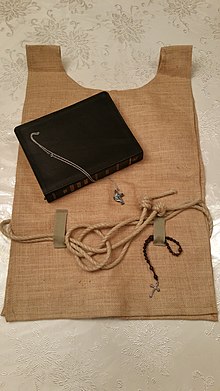Cilice


A cilice
Hairshirt cilices were originally made from coarse animal hair, as an imitation of the garment worn by John the Baptist that was made of camel hair,[8] or sackcloth which, throughout the Bible, was worn by people repenting.[9] Cilices were designed to irritate the skin; other features were added to make cilices more uncomfortable, such as thin wires or twigs. In modern Christian religious circles, cilices are simply any device worn for the same purposes, often taking the form of a hairshirt cilice as well as a (spiked metal) chain cilice.[10]
Etymology
The word cilice derives from the
Use


There is some evidence, based on analyses of both clothing represented in art and preserved skin imprint patterns at Çatalhöyük in Turkey, that the usage of the cilice predates written history. This finding has been mirrored at Göbekli Tepe, another Anatolian site, indicating the widespread manufacturing of cilices. Ian Hodder has argued that "self-injuring clothing was an essential component of the Catalhöyük culturo-ritual entanglement, representing 'cleansing' and 'lightness'."[13]
In Biblical times, it was the
Cilices have been used for centuries in the
Some high church Anglicans, including Edward Bouverie Pusey, wore hairshirts as a part of their spirituality.[4]
In the Presbyterian Church of Scotland, influenced by the evangelical revival, penitents were dressed in sackcloth and called in front of the chancel, where they were ordered to admit their sins.[6]
In some Methodist churches, on Ash Wednesday, communicants, along with receiving ashes, also receive a piece of sackcloth "as a reminder of our own sinful ways and need for repentance".[26]
In popular culture

In
The goat hair of Thomas More, presented for safe keeping by Margaret Clement,[28] was long in the custody of the community of Augustinian canonesses who until 1983 lived at the convent at Abbotskerswell Priory, Devon. Some sources, including one from 2004, claimed that the shirt was then at the Martyr's church on the Weld family's estate in Chideock, Dorset.[29][30] In 2011 the shirt was put on public display at Buckfast Abbey, near Buckfastleigh in Devon.[22]
See also
- Fasting
- Hairshirt environmentalism
- Hessian
References
- ISBN 9780802836342.
- ISBN 9780879736699.
- ^ Neve, Juergen Ludwig (1914). The Augsburg Confession: A Brief Review of Its History and an Interpretation of Its Doctrinal Articles, with Introductory Discussions on Confessional Questions. Lutheran Publication Society. p. 150.
- ^ ISBN 9780191535017.regularly endured a hair shirt as well as self- imposed flagellation and fasting routines.
Pusey
- ISBN 9780567523686.
In fact, it was scandal of disunity within Methodism that led UMC leaders to address the issue of racism as the underlying cause. ... The petition for forgiveness proceeded on two distinct but interrelated levels. Each of the approximately 3,000 persons in the assemble was called to silent personal confession of the sin of racism before God, publicly symbolized by receiving ... sackcloth ... and the imposition of ashes.
- ^ ISBN 9781317866480.
The Evangelical revival in Scotland encouraged both much stricter conditions being placed on admission to Holy Communion and the maintenance of traditional discipline within the established church. ... Lesser transgressors could be ordered by the kirk session to stand before the congregation for up to three Sundays, sometimes wearing sackcloth, and publicly acknowledge their sins before 'being subjected to a "rant" from the minister'.
- ISBN 9780801469145.
- ^ Brewer, Ebenezer Cobham (1884). A Dictionary of Miracles: Imitative, Realistic, and Dogmatic. Chatto and Windus. p. 56.
- ISBN 978-1-4336-4811-3.
Sackcloth was worn during times of mourning and repentance, usually while sitting atop ashes (Gn 37:34; 1Kg 21:27; Mt 11:21).
- ISBN 978-1-5326-9382-3.
- ^ "Cilice". Online Etymology Dictionary. Retrieved 2012-06-30.
- ^ "The History of Hairshirts". Handwoven. Retrieved 2024-03-05.
- ^ Ian Hodder, "Çatalhöyük: The Leopard's Tale", Thames & Hudson, 2006.
- ^ Genesis 37:34
- ^ 2 Samuel 3:31
- ^ Esther 4:1
- ^ a b Kosloski, Philip (29 August 2019). "The spiritual symbolism of John the Baptist's unusual clothing". Aleteia. Retrieved 9 February 2022.
- ^ Matthew 3:4
- ^ 1 Peter 3:3
- ^ 1 Timothy 2:9
- ^ Barlow, Frank (2002). Thomas Becket. London: The Folio Society. pp. 299, 314.
- ^ a b Simon Caldwell (21 November 2016). "St. Thomas More's hair shirt now enshrined for public veneration". Catholic Telegraph.
- ^ a b Michael Barrett, a priest of Opus Dei (17 May 2006). "Opus Dei and Corporal Mortification" (Press release). Opus Dei.
- ^ Allen 2006, pp. 165, 169, 171–173.
- ^ Allen 2006, p. 173.
- ^ Ice, Roy E. (11 March 2017). "Sackcloth". St Paul's United Methodist Church. Archived from the original on 27 March 2017. Retrieved 27 March 2017.
- ^ Allen 2006, pp. 162–163.
- ^ "St. Thomas More". Catholic Encyclopaedia..
- ISBN 978-0-7524-6265-3.[page needed]
- ISBN 0-85244-603-9.
- Allen Jr., John (2006). Opus Dei: An Objective Look Behind the Myths and Reality of the Most Controversial Force in the Catholic Church. ISBN 9780385514507.
External links
- Herbermann, Charles, ed. (1910). . Catholic Encyclopedia. Vol. 7. New York: Robert Appleton Company.
- On the Latin word cilicium (with photograph of a 16c hairshirt)
- Suffering and Sainthood in the Catholic Church The importance of Penance and Mortification for those who desire to become a Catholic Saint
